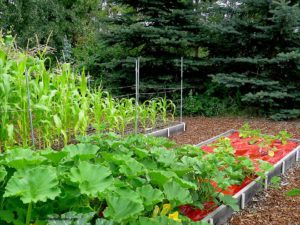The importance of sunlight in a vegetable garden

My Sunday column was an update on how my vegetable garden is doing. In it, I mentioned how I’ve learned firsthand just how important sunlight is for plant growth.
(If you missed my column, here’s a link to it: Wacky weather confusing to vegetable crops.)
On the south end of our garden, we have (3) 4′ wide by 16′ long raised beds. In them, we grow corn, tomatoes, winter squash and pumpkins. Every year we rotate which beds we grow in them. That way, we keep plants healthy and free from insect or disease problems.
To the east and south of those beds are trees my husband Bill has planted over the years. They’re primarily locust and aspen trees, but there’s also a really nice spruce tree that’s about 12 feet tall. They’ve never been tall enough to shade the garden so we haven’t had to worry about that issue.
That is, until this year. Darn! The corn bed is in the easternmost bed. The middle bed has winter squash and pumpkins, and the westernmost bed is filled with tomato plants.
About a month ago, I was checking on the beds and noticed something odd. In the corn and squash beds, the plants growing on the northern ends were robust and looking great. On the southern half of each of those two beds, the plants are stunted.
You’ll notice in the photo at the top post that the corn was looking pretty decent on the northern end. (toward the camera) That was a couple of weeks ago. But check out this shot from the side, which shows part of the corn bed and the squash bed. Isn’t it shocking what a difference there is between the plant sizes?
At first, I was concerned that something was going on with the drip irrigation system. Nope, everything’s working as it should. Then one morning, Bill pointed out the shade patterns on those two beds. Sure enough, that’s what’s causing the problem.
Now, a month later, the pattern is continuing. The northernmost plants are large and producing . But the southernmost plants are larger than a month ago but still significantly shorter and/or smaller than their counterparts. This is so frustrating!
As you can guess, we will do some serious pruning and/or tree removal within the next couple of months. When you read that a vegetable garden needs at least 6 hours of sunlight daily, they really mean it! And the more sun, the better.
If you find that your garden is struggling more than usual, study the light patterns. You might have a similar problem going on.

